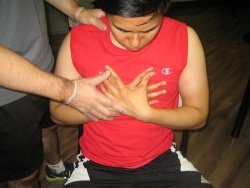
A broken rib, or rib fracture, is a common injury that occurs when one of the bones in your rib cage breaks or cracks. The most common cause of broken ribs is trauma to the chest, such as from a fall, motor vehicle accident or impact during contact sports. Many broken ribs are merely cracked. While still painful, cracked ribs aren’t as potentially dangerous as ribs that have been broken. In these situations, a jagged piece of bone could damage major blood vessels or internal organs, such as the lungs. In most cases, broken ribs heal on their own in one or two months. Adequate pain control is important, so you can continue to breathe deeply and avoid lung complications, such as pneumonia.
The material posted on this page on rib fractures and pain management is for learning purposes only. To learn to recognizing skeletal injuries including open fractures, broken bones and spinal injuries register for a standard first aid course with our training providers.
Rib Fracture Symptoms
Symptoms of a broken rib may include pain when one takes a deep breath, and pain that gets worse when you press on the injured area, or when you bend or twist your body. It is advisable to see a doctor if one has a very gentle spot in the rib area that occurs after shock, is present with deep breaths or if it prevents one’s breathing. Nonetheless, should one experience pressure, fullness or a squeezing pain in the center of the chest that lasts for more than a few minutes, pain that extends beyond the chest to one’s shoulder or arm, and increasing episodes of chest pain, get medical attention immediately. These symptoms may indicate a heart attack.
Rib Fracture Causes
Causes of direct impact include motor vehicle accidents, child abuse, contact sports and falls whereas broken ribs emanating from repetitive trauma include sports such as golf or rowing and severe and prolonged coughing spells.
Rib Fracture Risk factors
The following factors can increase the risk of breaking a rib: Having osteoporosis which is a disease in which one’s bones lose their density, making him more vulnerable to a bone fracture, participating in contact sports like hockey or football also increases the risk of pain to a person’s chest, and trauma increases the risk of rib fractures; A cancerous lesion can also weaken the bone to make it more prone to breaks.
Complications Distinct from a fractured rib, a totally broken rib can injure blood vessels and internal organs whose risk increases with the number of broken ribs. Complications thus vary depending on which ribs have been broken. Possible complications include torn or punctured aorta, punctured lung and lacerated spleen, liver or kidneys.
Prevention In order to help prevent a broken rib, measures such as protection of oneself from athletic injuries, wearing protective equipment when playing contact sports, taking steps to decrease the risk of household falls and decreasing the chances of getting osteoporosis like getting enough calcium in the diet.